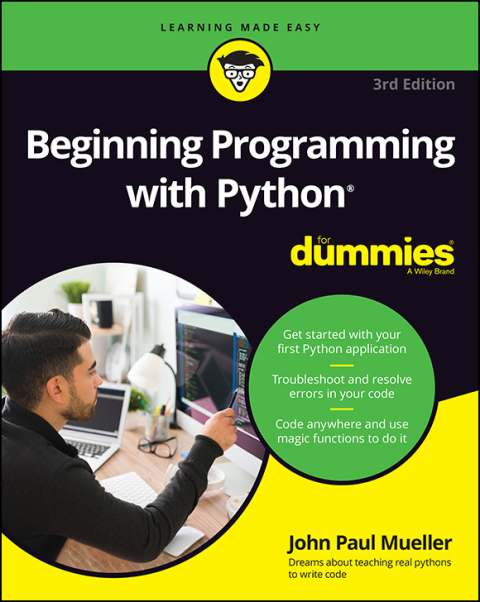Description
Efnisyfirlit
- Cover
- Title Page
- Copyright
- Introduction
- About This Book
- Foolish Assumptions
- Icons Used in This Book
- Beyond the Book
- Where to Go from Here
- Part 1: Getting Started with Python
- Chapter 1: Talking to Your Computer
- Understanding Why You Want to Talk to Your Computer
- Knowing that an Application Is a Form of Communication
- Defining What an Application Is
- Understanding Why Python Is So Cool
- Chapter 2: Working with Google Colab
- Defining Google Colab
- Working with Notebooks
- Performing Common Tasks
- Using Hardware Acceleration
- Executing the Code
- Getting Help
- Chapter 3: Interacting with Python
- Typing a Command
- Getting Python’s Help
- Finding Out More about Functions and Objects
- Playing the Part of Inspector
- Chapter 4: Writing Your First Application
- Understanding Why IDEs Are Important
- Creating the Application
- Running the Application
- Understanding the Use of Indentation
- Adding Comments
- Making Your Notebook Informative, Descriptive, and Pretty
- Closing and Halting a Notepad
- Chapter 5: Performing Magic
- Understanding the Concept of a Magic Command
- What Kind of Magic Do You Want to Perform?
- Learning the Magic Commands
- Part 2: Talking the Talk
- Chapter 6: Storing and Modifying Information
- Storing Information
- Defining the Essential Python Data Types
- Working with Dates and Times
- Chapter 7: Managing Information
- Controlling How Python Views Data
- Working with Operators
- Creating and Using Functions
- Getting User Input
- Chapter 8: Making Decisions
- Making Simple Decisions by Using the if Statement
- Choosing Alternatives by Using the if…else Statement
- Using Nested Decision Statements
- Chapter 9: Performing Repetitive Tasks
- Processing Data Using the for Statement
- Processing Data by Using the while Statement
- Nesting Loop Statements
- Chapter 10: Dealing with Errors
- Knowing Why Python Doesn’t Understand You
- Considering the Sources of Errors
- Catching Exceptions
- Raising Exceptions
- Deciding to Say “Oops” in Your Own Way: Custom Exceptions
- Using the finally Clause
- Part 3: Performing Common Tasks
- Chapter 11: Interacting with Packages
- Creating Code Groupings
- Importing Packages
- Finding Packages
- Downloading Packages from Other Sources
- Viewing the Package Content
- Viewing Package Documentation
- Chapter 12: Working with Strings
- Understanding That Strings Are Different
- Creating Stings with Special Characters
- Selecting Individual Characters
- Slicing and Dicing Strings
- Locating a Value in a String
- Using String Interpolation
- Chapter 13: Managing Lists
- Organizing Information in an Application
- Creating Lists
- Accessing Lists
- Looping through Lists
- Modifying Lists
- Searching Lists
- Sorting Lists
- Printing Lists
- Working with the Counter Object
- Chapter 14: Collecting All Sorts of Data
- Understanding Collections
- Working with Tuples
- Working with Dictionaries
- Creating Stacks Using Lists
- Working with queues
- Working with deques
- Chapter 15: Creating and Using Classes
- Considering the Parts of a Class
- Creating and Using an External Class
- Extending Classes to Make New Classes
- Part 4: Performing Advanced Tasks
- Chapter 16: Storing Data in Files
- Understanding How Permanent Storage Works
- Creating Content for Permanent Storage
- Creating a File
- Reading File Content
- Updating File Content
- Deleting a File
- Chapter 17: Sending an Email
- Understanding What Happens When You Send Email
- Part 5: The Part of Tens
- Chapter 18: Ten Amazing Programming Resources
- Working with the Python Documentation Online
- Discovering Details Using a Tutorial
- Performing Web Programming by Using Python
- Locating Useful (versus Useless) Modules
- Creating Applications Faster by Using an IDE
- Checking Your Syntax with Greater Ease
- Using XML to Your Advantage
- Getting Past the Common Python Newbie Errors
- Understanding Unicode
- Making Your Python Application Fast
- Chapter 19: Ten Ways to Make a Living with Python
- Working in QA
- Becoming the IT Staff for a Smaller Organization
- Performing Specialty Scripting for Applications
- Administering a Network
- Teaching Programming Skills
- Helping People Decide on Location
- Performing Data Mining
- Interacting with Embedded Systems
- Carrying Out Scientific Tasks
- Performing Real-Time Analysis of Data
- Chapter 20: Ten Tools That Enhance Your Python Experience
- Tracking Bugs with Roundup Issue Tracker
- Creating a Virtual Environment by Using VirtualEnv
- Installing Your Application by Using PyInstaller
- Building Developer Documentation by Using pdoc
- Developing Application Code by Using Komodo Edit
- Debugging Your Application by Using pydbgr
- Entering an Interactive Environment by Using IPython
- Testing Python Applications by Using PyUnit
- Tidying Your Code by Using Isort
- Providing Version Control by Using Mercurial
- Chapter 21: Ten (Plus) Libraries You Need to Know About
- Developing a Secure Environment by Using CryptLib
- Interacting with Databases by Using SQLAlchemy
- Seeing the World by Using Google Maps
- Adding a Graphical User Interface by Using TkInter
- Providing a Nice Tabular Data Presentation by Using PrettyTable
- Enhancing Your Application with Sound by Using PyAudio
- Manipulating Images by Using PyQtGraph
- Locating Your Information by Using Whoosh
- Creating an Interoperable Java Environment by Using JPype
- Accessing Local Network Resources by Using Twisted Matrix
- Accessing Internet Resources by Using Libraries
- Index
- About the Author
- Advertisement Page
- Connect with Dummies
- End User License Agreement







Reviews
There are no reviews yet.